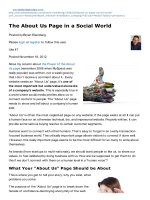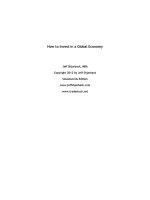Maths in minutes 200 key concepts explained in a INstant
Bạn đang xem bản rút gọn của tài liệu. Xem và tải ngay bản đầy đủ của tài liệu tại đây (12.95 MB, 352 trang )
Math in Minutes
Math in Minutes
Paul Glendinning
New York • London
© 2012 by Paul Glendinning
First published in the United States by Quercus in 2013
All rights reserved. No part of this book may be reproduced in any form or by any electronic or
mechanical means, including information storage and retrieval systems, without permission in writing
from the publisher, except by reviewers, who may quote brief passages in a review. Scanning,
uploading, and electronic distribution of this book or the facilitation of the same without the
permission of the publisher is prohibited.
Please purchase only authorized electronic editions, and do not participate in or encourage electronic
piracy of copyrighted materials. Your support of the author’s rights is appreciated.
Any member of educational institutions wishing to photocopy part or all of the work for classroom
use or anthology should send inquiries to Permissions c/o Quercus Publishing Inc., 31 West 57th
Street, 6th Floor, New York, NY 10019, or to
e-ISBN: 978-1-62365-009-4
Distributed in the United States and Canada by Random House Publisher Services
c/o Random House, 1745 Broadway
New York, NY 10019
www.quercus.com
Picture credits:
All pictures are believed to be in the public domain except:
135: © Oxford Science Archive/Heritage Images/Imagestate; 179: Deutsche Fotothek/Wikimedia;
229: D.328/Wikimedia; 279: Jgmoxness/Wikimedia; 293: Time3000/Wikimedia; 299: Adam
Majewski/Wikimedia; 367: fromoldbooks.org; 389: Grontesca/Wikimedia; 399: Sam
Daoud/Wikimedia.
Contents
Introduction
Numbers
Sets
Sequences and series
Geometry
Algebra
Functions and calculus
Vectors and matrices
Abstract algebra
Complex numbers
Combinatorics
Spaces and topology
Logic and proof
Number theory
Glossary
Index
Introduction
M
athematics has been evolving for over four thousand years. We still measure angles using the
360-degree system introduced by the Babylonians. Geometry came of age with the ancient Greeks,
who also understood irrational numbers. The Moorish civilization developed algebra and
popularized the idea of zero as a number.
Mathematics has a rich history for good reason. It is both stunningly useful—the language of
science, technology, architecture, and commerce—and profoundly satisfying as an intellectual pursuit.
Not only does mathematics have a rich past, but it continues to evolve, both in the sophistication of
approaches to established areas and in the discovery or invention of new areas of investigation.
Recently computers have provided a new way to explore the unknown, and even if traditional
mathematical proofs are the end product, numerical simulations can provide a source of new intuition
that speeds up the process of framing conjectures.
Only a lunatic would pretend that all mathematics could be presented in 200 bite-sized chunks.
What this book does attempt to do is to describe some of the achievements of mathematics, both
ancient and modern, and explain why these are so exciting. In order to develop some of the ideas in
more detail it seemed natural to focus on core mathematics. The many applications of these ideas are
mentioned only in passing.
The ideas of mathematics build on each other, and the topics in this book are organized so that
cognate areas are reasonably close together. But look out for long-range connections. One of the
amazing features of mathematics is that apparently separate areas of study turn out to be deeply
connected. Monstrous moonshine (page 300) provides a modern example of this, and matrix equations
(page 272) a more established link.
This book is thus a heady distillation of four thousand years of human endeavor, but it can only be a
beginning. I hope it will provide a springboard for further reading and deeper thought.
Paul Glendinning,
October 2011
Numbers
N
umbers at their most elementary are just adjectives describing quantity. We might say, for
instance, “three chairs” or “two sheep.” But even as an adjective, we understand instinctively that the
phrase “two and a half goats” makes no sense. Numbers, then, can have different uses and meanings.
As ancient peoples used them in different ways, numbers acquired symbolic meanings, like the
water lily that depicts the number 1000 in Egyptian hieroglyphs. Although aesthetically pleasing, this
visual approach does not lend itself to algebraic manipulation. As numbers became more widely
used, their symbols became simpler. The Romans used a small range of basic signs to represent a
huge range of numbers. However, calculations using large numbers were still complicated.
Our modern system of numerals is inherited from the Arabic civilizations of the first millennium
AD. Using 10 as its base (see page 18), it makes complex manipulations far easier to manage.
Natural numbers
N
atural numbers are the simple counting numbers (0, 1, 2, 3, 4, . . .). The skill of counting is
intimately linked to the development of complex societies through trade, technology, and
documentation. Counting requires more than numbers, though. It involves addition, and hence
subtraction too.
As soon as counting is introduced, operations on numbers also become part of the lexicon—
numbers stop being simple descriptors, and become objects that can transform each other. Once
addition is understood, multiplication follows as a way of looking at sums of sums—how many
objects are in five groups of six?—while division offers a way of describing the opposite operation
to multiplication—if thirty objects are divided into five equal groups, how many objects are in each?
But there are problems. What does it mean to divide 31 into 5 equal groups? What is 1 take away
10? To make sense of these questions we need to go beyond the natural numbers.
One
T
ogether with zero, the number one is at the heart of all arithmetic. One is the adjective for a
single object: by repeatedly adding or subtracting the number to or from itself, all the positive and
negative whole numbers, the integers, can be created. This was the basis of tallying, perhaps the
earliest system of counting, whose origins can be traced back to prehistoric times. One also has a
special role in multiplication: multiplying any given number by one simply produces the original
number. This property is expressed by calling it the multiplicative identity.
The number one has unique properties that mean it behaves in unusual ways—it is a factor of all
other whole numbers, the first nonzero number and the first odd number. It also provides a useful
standard of comparison for measurements, so many calculations in mathematics and science are
normalized to give answers between zero and one.
Zero
Z
ero is a complex idea, and for a long time there was considerable philosophical reluctance to
recognize and put a name to it. The earliest zero symbols are only found between other numerals,
indicating an absence. The ancient Babylonian number system, for instance, used a placeholder for
zero when it fell between other numerals, but not at the end of a number. The earliest definitive use of
zero as a number like any other comes from Indian mathematicians around the ninth century.
Aside from philosophical concerns, early mathematicians were reluctant to embrace zero because
it does not always behave like other numbers. For instance, division by zero is a meaningless
operation, and multiplying any number by zero simply gives zero. However, zero plays the same role
in addition as one does in multiplication. It is known as the additive identity, because any given
number plus zero results in the original number.
Infinity
I
nfinity (represented mathematically as ∞) is simply the concept of endlessness: an infinite object is
one that is unbounded. It is hard to do mathematics without encountering infinity in one form or
another. Many mathematical arguments and techniques involve either choosing something from an
infinite list, or looking at what happens if some process is allowed to tend to infinity, continuing
toward its infinite limit.
Infinite collections of numbers or other objects, called infinite sets (see page 48), are a key part of
mathematics. The mathematical description of such sets leads to the beautiful conclusion that there is
more than one sort of infinite set, and hence there are several different types of infinity.
In fact there are infinitely many, bigger and bigger, kinds of infinite set, and while this may seem
counterintuitive, it follows from the logic of mathematical definitions.
Number systems
A
number system is a way of writing down numbers. In our everyday decimal system, we represent
numbers in the form 434.15, for example. Digits within the number indicate units, tens, hundreds,
tenths, hundredths, thousandths and so on, and are called coefficients. So 434.15 = (4 × 100) + (3 ×
10) + (4 × 1) +
+
. This is simply a shorthand description of a sum of powers of ten
(see page 28), and any real number (see page 22) can be written in this way.
But there is nothing special about this “base 10” system. The same number can be written in any
positive whole-number base n, using coefficients ranging from 0 up to n − 1. For example, in base
two or binary, the number 8
can be written as 1000.0101. The coefficients to the left of the
decimal point show units, twos, fours, and eights—powers of 2. Those to the right show halves,
quarters, eighths, and sixteenths. Most computers use the binary system, since two coefficients (0 and
1) are easier to work with electronically.
The number line
T
he number line is a useful concept for thinking about the meaning of mathematical operations. It is
a horizontal line, with major divisions marked by the positive and negative whole numbers stretching
away in each direction. The entire range of whole numbers covered by the number line are known as
the integers.
Addition of a positive number corresponds to moving to the right on the number line by a distance
equivalent to the given positive number. Subtraction of a positive number corresponds to moving to
the left by that positive distance. Thus one minus ten means moving 10 units to the left of 1, resulting
in minus nine, written −9.
In between the whole number integers shown, there are other numbers, such as halves, thirds, and
quarters. These are ratios formed by dividing any integer by a nonzero integer. Together with the
natural numbers—zero and the positive whole numbers, which are effectively ratios divided by 1—
they form the rational numbers. These are marked by finer and finer subdivisions of the number line.
But do the rational numbers complete the number line? It turns out that almost all the numbers
between zero and one cannot be written as ratios. These are known as irrational numbers, numbers
whose decimal representations never stop and are not eventually repeating. The complete set of
rationals and irrationals together are known as the real numbers.
Families of numbers
N
umbers can be classified into families of numbers that share certain properties. There are many
ways of putting numbers into classes in this way. In fact, just as there is an infinity of numbers, there
is an infinite variety of ways in which they can be subdivided and distinguished from one another. For
example the natural numbers, whole numbers with which we count objects in the real world, are just
such a family, as are the integers—whole numbers including those less than zero. The rational
numbers form another family, and help to define an even larger family, the irrational numbers. The
families of algebraic and transcendental numbers (see page 38) are defined by other behaviors
while the members of all these different families are members of the real numbers, defined in
opposition to the imaginary numbers (see page 46).
Saying that a number is a member of a certain family is a shorthand way of describing its various
properties, and therefore clarifying what sort of mathematical questions we can usefully ask about it.
Often, families arise from the creation of functions that describe how to construct a sequence of
numbers. Alternatively, we can construct a function or rule to describe families that we recognize
intuitively.
For instance, we instinctively recognize even numbers, but what are they? Mathematically, we
could define them as all natural numbers of the form 2 × n where n is itself a natural number.
Similarly, odd numbers are natural numbers of the form 2n + 1, while prime numbers are numbers
greater than 1, whose only divisors are 1 and themselves.
Other families arise naturally in mathematics—for example in the Fibonacci numbers (1, 2, 3, 5, 8,
13, 21, 34, . . .), each number is the sum of the previous two. This pattern arises naturally in both
biology and mathematics (see page 86). Fibonacci numbers are also closely connected to the golden
ratio (see page 37).
Other examples include the multiplication tables, which are formed by multiplying the positive
integers by a particular number, and the squares, where each number is the product of a natural
number with itself: n times n, or n2, or n squared.
Combining numbers
T
here are a number of different ways of combining any two given numbers. They can be added
together to form their sum, subtracted to form their difference, multiplied together to form their
product, and divided, provided the divisor is nonzero, to form their ratio. In fact, if we think of a − b
as a + (−b) and
as a ×
, then the only operations really involved are addition and
multiplication, together with taking the reciprocal to calculate .
Addition and multiplication are said to be commutative, in that the order of the numbers involved
does not matter, but for more complicated sequences, the order in which operations are performed
can make a difference. To aid clarity in these cases, certain conventions have been developed. Most
important, operations to be performed first are written in brackets. Multiplication and addition also
satisfy some other general rules about how brackets can be reinterpreted, known as associativity and
distributivity, demonstrated opposite.
Rational numbers
R
ational numbers are numbers that can be expressed by dividing one integer by another nonzero
integer. Thus all rational numbers take the form of fractions or quotients. These are written as one
number, the numerator, divided by a second, the denominator.
When expressed in decimal form, rational numbers either come to an end after a finite number of
digits, or one or a number of digits are repeated forever. For instance, 0.3333333 . . . is a rational
number expressed in decimal form. In fraction form, the same number is . It is also true to say that
any decimal number that comes to an end or repeats must be a rational number, expressible in
fractional form.
Since there is an infinite number of integers, it is not surprising to find that there are an infinite
number of ways of dividing one by another, but this does not mean there is a “greater infinity” of
rational numbers than that of the integers.
Squares, square roots, and powers
T
he square of any number x is the product of the number times itself, denoted x2. The term
originates from the fact that the area of a square (with equal sides) is the length of a side times itself.
The square of any nonzero number is positive, since the product of two negative numbers is positive,
and the square of zero is zero. Conversely, any positive number must be the square of two numbers, x
and −x. These are its square roots.
More generally, multiplying a number x by itself n times gives x to the power of n, written xn.
Powers have their own combination rules, which arise from their meaning:
xn × xm = xn+m, (xn)m = xnm, x0 = 1, x1 = x, and x−1 =
It also follows from the formula (xn)m = xnm that the square root of a number can be thought of as that
number raised to the power of one-half, i.e.,
.
Prime numbers
P
rime numbers are positive integers that are divisible only by themselves and 1. The first eleven
are 2, 3, 5, 7, 11, 13, 17, 19, 23, 29, and 31, but there are infinitely many. By convention, 1 is not
considered prime, while 2 is the only even prime. A number that is neither 1 nor a prime is called a
composite number.
Every composite number can be written uniquely as a product of prime factors multiplied together:
for example, 12 = 22 × 3, 21 = 3 × 7, and 270 = 2 × 33 × 5. Since prime numbers cannot be factorized
themselves, they can be thought of as the fundamental building blocks of positive integers. However,
determining whether a number is prime, and finding the prime factors if it is not, can be extremely
difficult. This process is therefore an ideal basis for encryption systems.
There are many deep patterns to the primes, and one of the great outstanding hypotheses of
mathematics, the Riemann hypothesis (see page 396), is concerned with their distribution.









